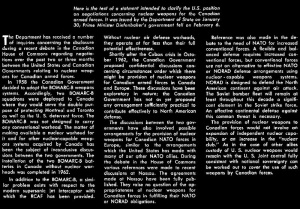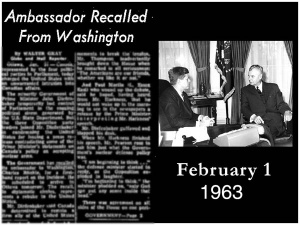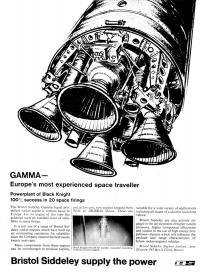The Empire Strikes Out - Canada's Defence & The Commonwealth Space Program - Part 8 by Robert Godwin
From The Space Library
Diefenbaker's decision to not equip Bomarc with nuclear warheads would lead to an unparalleled rift between the USA and Canada. Demonstrating an almost breathtaking ignorance of the situation one of the options Diefenbaker's cabinet had seriously considered was having the nuclear warheads delivered to Canada only in the case of an emergency. They would only be fitted to the delivery systems when required, apparently accepting the fact that the fallout would still rain down on Canada.68 This option would however allow the Prime Minister the ability to say that he hadn't been "proliferating."
U.S. State Department public statement about Canada's defence policy decision (January 1963)
Public fallout from Canadian government proposal to not arm Bomarc (February 1963)
Diefenbaker’s legendary ability to rely on rhetoric had finally come back to haunt him. He had tried to play both sides of the nuclear issue by buying missiles, but not arming them. A public statement issued by the US State Department revealing his indecisiveness created chaos in Ottawa. Although the big issue was about placing nuclear warheads in Canada, the ability to use them while the Soviet bombers were still out in the arctic seemed to completely contradict the logic of cancelling the Avro Arrow.
“The Soviet bomber fleet will remain at least throughout this decade a significant element in the Soviet strike force. An effective continental defense against this common threat is necessary.” U.S. State Department Press Release
Meanwhile, MacMillan returned to England and announced the Polaris deal on the very same day that Diefenbaker recalled his Ambassador from Washington. Diefenbaker then told the Canadian parliament that the Nassau agreement between Britain and the United States put the whole defence role of Canada up for question.69
Announcement that Canada has recalled Ambassador from Washington over Bomarc issue (February 1963)
William Hessler70, a highly respected American journalist and policy expert questioned the timing of the U.S. government’s public statement and handling of these sensitive issues. His assessment was that incompetence on both sides of the border seemed to be in play.
“Our cancellation of Skybolt let an ally, Great Britain, down. The thrust at Ottawa was a case of trying to bully an ally. But the two had one important element in common. They arose from failure in the State Department to take adequate account of the internal political currents of two major allies—the two countries above all others whose politics American officials should find it easiest to understand and keep abreast of. To make matters worse, both the British and the Canadian governments were in trouble with their own parliaments and peoples.”71
In the next few days Douglas Harkness resigned as Canada's Defence Minister and Diefenbaker's cabinet began to crack apart. Two days later his government collapsed.72
John Diefenbaker resigns as Prime Minister of Canada after his cabinet rebels over defence policy (April 1963)
Polaris would be a phenomenally good deal for the British military but of course it did nothing for space exploration.
Just six months after Diefenbaker had lost his job, MacMillan quit his. Despite his resounding success acquiring Polaris many observers felt that his handling of the defence portfolio and specifically Blue Streak/Skybolt had let the country down.
Canada's entry into the space era, the Alouette satellite, would be launched in 1962 on a Thor missile, similar to that which Blue Streak would have replaced. Alouette was delayed by over a year because the American Thor-Delta launch system originally proposed was not capable of lofting its 318 pound weight into the orbit required.73 The Thor-Agena ended up doing the job in September 1962, a year later than Blue Streak/Black Knight could almost certainly have launched two Alouettes. Britain contributed to the success of Alouette by providing two-way sounding and transmission in England, Nigeria and Singapore. This modest alliance was all that remained of a Commonwealth program that included Canada.74
MacMillan signed a deal with Germany and France and Blue Streak would go on to become one of the cornerstones on which the European Space Agency was built—although not before there were many more twists and turns to that part of the story.
The German Defence minister Franz Josef Strauss, who had been responsible for purchasing the F-104G from Lockheed for the German Air Force with the same catastrophic results, agreed to a European space program but wanted to buy "proven" American rockets rather than use Blue Streak.75 He relented when Germany was given part of the rocket system contract.
In 1966 the newly elected British Labour government began wrangling with the French about how much money they would continue to contribute to the European launch system. Blue Streak was now the first stage of this system with the French and Germans providing the upper stages. Britain was contributing 40% of the money and threatened to pull out if this wasn't reduced to 27%. In April of 1967 the same government ordered a small number of British-built satellite launchers which would be derived from technology developed for the much smaller Black Knight. This vehicle would be developed to a high level of refinement and would become known as the Black Arrow. It would be an all-British three stage booster using a non-cryogenic fuel system. The engines on Black Arrow used high-test peroxide (HTP) and kerosene and were extremely reliable. Britain's expertise in the use of HTP almost certainly went all the way back to the importation of Johannes Schmidt and his team of engineers from Germany in 1946.
Despite the clean burning and highly reliable Bristol Siddeley Gamma engines, which launched 26 rockets without a single failure, the Black Arrow only had about a third of the lifting power of Blue Streak.76
Advertisement for Armstrong Siddeley Gamma rocket engine.
By 1968 the government in England declined to contribute more funds to the European space launch system and France's General De Gaulle used that decision as another excuse to preclude Britain from joining the European Common Market. He blamed himself for allowing MacMillan to dump the cost of Blue Streak onto Europe while adopting Polaris.77
By the summer of 1971 British government interest in space waned again. The British Aerospace Minister when asked why Britain didn't have a more robust space program made a very revealing comment, "The Canadians were the first people to put a satellite into orbit after the Americans and they do it the same way we do."78 i.e. aboard U.S. rockets.
Black Arrow would launch a British satellite from Woomera three months later. The program was cancelled before the launch. The first successful satellite launch would also be the last flight of Black Arrow and the end of British space launchers.
Black Arrow launches Britain's satellite Prospero in October 1971
A few years later the BBC ran a documentary appropriately entitled The Bulldog's Last Bark in which Blue Streak chief engineer Geoffrey Pardoe explained the sad story of this historic missed opportunity. Six years later the two main advocates from opposite sides of the Atlantic, Britain's Pardoe and Canada's Phil Lapp, would partner up on the Radarsat project in an attempt to once more create a major space technology alliance between their two countries.
The Empire Strikes Out - Canada's Defence & The Commonwealth Space Program - Part 9 by Robert Godwin
Footnotes
68Globe and Mail Feb 1 1963
69Ibid Feb 1 1963
70Foreign editor of The Cincinnati Enquirer, Director of University of Cincinnati, US Navy officer and correspondent for Harper's and Collier's magazines.
71The Reporter Feb 28 1963
72Ibid Feb 6 1963
73Montreal Gazette Feb 18 1961
74Flight Jun 3 1960
75Space Technology in Western Europe – Kenneth Gatland 1963
76Ibid Jul 27 1967
77The Reporter Apr 27 1968
78Toronto Star July 31 1971






